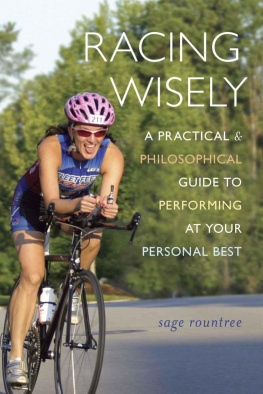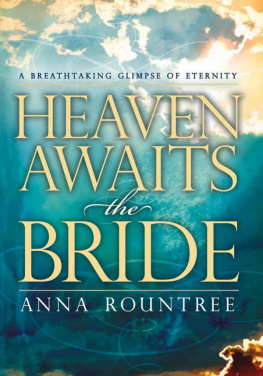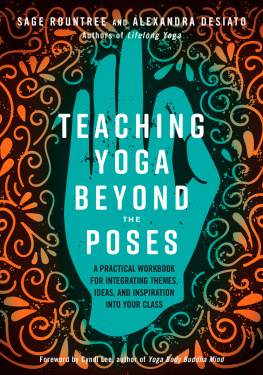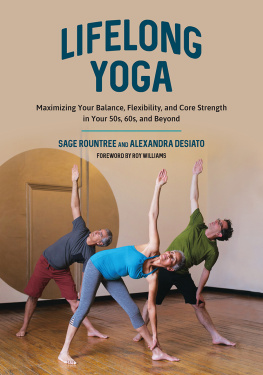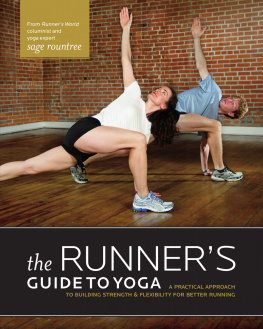Also by Sage Rountree
The Athletes Guide to Yoga
The Athletes Pocket Guide to Yoga
The Athletes Guide to Recovery
The Runners Guide to Yoga
Racing Wisely
A Practical and Philosophical Guide to Performing at Your Personal Best
sage rountree

Copyright 2013 by Sage Rountree
All rights reserved
No part of this book may be reproduced, stored in a retrieval system, or transmitted, in any form or by any means, electronic or photocopy or otherwise, without the prior written permission of Sage Rountree except in the case of brief quotations within critical articles and reviews.
ISBN 978-1-890586-29-4
eISBN 978-1-890586-30-0
Library of Congress Cataloging-in-Publication Data
Rountree, Sage Hamilton.
Racing wisely : a practical and philosophical guide to performing at your personal best / Sage Rountree.
pages cm
Includes bibliographical references and index.
Description based on print version record and CIP data provided by publisher; resource not viewed.
ISBN 978-1-890586-30-0 () -- ISBN 978-1-890586-29-4 (alk. paper)
1. Running--Training. 2. Running races. 3. Running--Philosophy. I. Title.
GV1061.5
796.42071--dc23
2013032124
Cover design by BW&A Books
Cover photograph by Steve Lackey, Endurance magazine
Book and ebook production services by TIPS Technical Publishing, Inc.
Ironman is a trademark of the World Triathlon Corporation
For rescue workers and service members past and present, especially Jeff Cummer, who work their hardest to bring us the safety and freedom to pursue our own personal best.
Knowledge consists of knowing that a tomato is a fruit, and wisdom consists of not putting it in a fruit salad.
Miles Kington
Brief Contents
Contents
Foreword
by Matt Fitzgerald
H OW MANY WORKOUTS DO YOU record in your training log for each race you start? Forty? Eighty? If youre like most endurance athletes, the ratio is somewhere in that range.
By the numbers, racing is a small part of the endurance sports experience. Yet its importance is much greater than the numbers indicate. The few races we participate in each year are the fundamental point of the hundreds of workouts we do. Sure, we still would exercise even if we didnt compete, but we wouldnt exercise the same way. In the life of the competitive endurance athlete, every session is planned and executed as a stepping-stone toward performing at ones personal best in a future event.
Look at it this way: If you make a mistake in training that results in a bad workout, or even a whole week of bad workouts, its unlikely that youll lose much sleep. Just fix it and move on. But if you make a mistake that results in a disastrous A race, you may never forgive yourself. All the good training you did to prepare for that race will have been (from one perspective) wasted. Thats how important racing is in relation to training.
Yet training gets vastly more attention than racing does in the information resources that are available to endurance athletes. The typical book for cyclists, runners, or triathletes contains ten or twelve chapters on all aspects of training and at most a single chapter with advice on racing. Experts seem content to hold their athletes hands through every step of the training process and then abandon them to fend for themselves on race day.
Some athletes fend for themselves quite well, but the majority learns too many lessons the hard way, and many never reach a point where they race as well as they train. Some even suffer the fate of being branded workout warriorsathletes who kick butt in workouts only to get their butts kicked in real competition.
Racing is an art that anyone can master, but this requires that it be treated as a problem unto itself, a challenge that is linked to but distinct from training, and studied in the same way we all study the art of training. The book you are about to read will help you tremendously in that process. Sage Rountree has made a career of filling the gaps in guidance for endurance athletes, and she has done it again with this comprehensive and practical guide. Whether your usual race goal is to finish or to win, Sages collected wisdom will give you a huge boost toward consistently performing at your personal best in competition. Whatever is holding you back from racing as well as you could, you will find a way through it in these pages.
Frankly, I am something of a workout warrior myself. Ive been racing for thirty years, but this new bible of racing has given me a perspective and some ideas that I cant wait to try in my next big race. And I know it will do the same for you.

Preface
INTENTION
A S A YOGA TEACHER, IM big on intention, and as an endurance sports coach, Im big on goals. While writing this book, Ive refined my understanding of intention, goals, and the difference between the two. Both are important for success. Intention, as well use the term here, refers to the attitude you bring to a situation. Its a quality, and as such, it cant really be measured. Intention is internal and private. Goals, on the other hand, are quantifiable, measurable, external, and public. Goals are useful in helping us control all the things we can control as we prepare to race: our training, our nutrition, our equipment, our pacing. Intentions are useful in helping us remember to bring the right attitude to all the things we cant control in a race. Goals are practical. Intentions are philosophical.
My intention in writing this book is to share the experience Ive gained as an endurance sports athlete, a coach, and even as a yoga teacher to help you define and reach your own personal best in whatever kind of racing gives you joy. I hope you can learn from my mistakes, and from the mistakes of athletes I interviewedthey were shared generously and with good humor. I hope you can learn from our successes, too. Some advice here will be familiar, such as nothing new on race day. (Start repeating that mantra right now.) Other advicepack duct tape!will be new. All of this advice, from broad to specific, can have an enormous impact on helping you free your energy from the myriad distractions of racing so you can focus it on what counts.
I also want you to consider exactly what it is that counts. Is it a time? Is it a place? Is it being stronger than before? Is it being a good sport? Is it learning about your limits? Is it inspiring others? Are your goals and your actions in line with your intentions? Is your sport making you a better, more self-aware, kinder person?
While the bulk of my personal experience is in running and triathlon events, I hope athletes competing in endurance tests of any discipline and length will find both practical and philosophical information here. I hope it will spur you toward self-reflection and help you as you strive for your own personal best. And I hope you will let me know how it goesyou can find me at sagerountree.com.

Introduction
GOALS
T O PERFORM AT YOUR PERSONAL best, you need to control what you can, accept what you cant, and be wise enough to know the difference between the two. When you are both practical, planning for every variable you expect to encounter on race day, and philosophical, recognizing that the unexpected happens and the one thing you can control in any situation is your attitude, youre primed for peak performance. In this book, we think through what steps, from planning to training to taper to warmup, will set you up to do your personal best on race day; how to stay focused during the race, even as intensity mounts; and how to use your training and racing to better understand yourself, your strengths, and your abilities.
Next page
